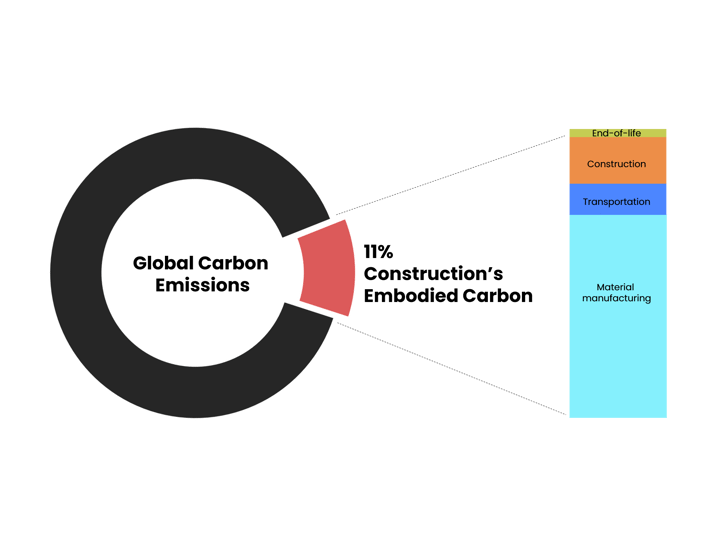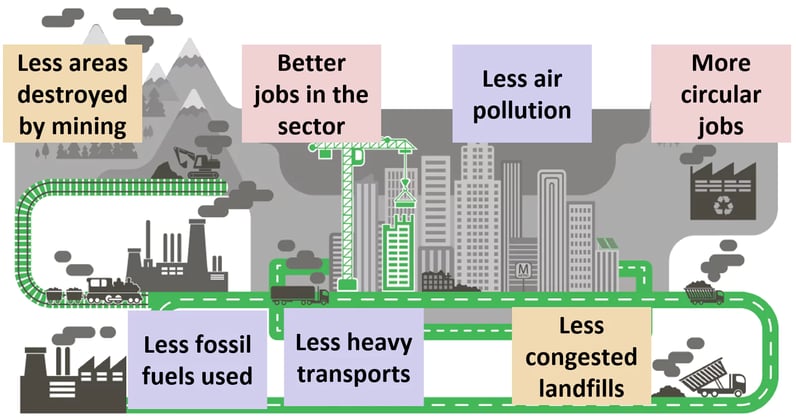
Source: Pexels
Embodied carbon in construction is the next frontier for cutting carbon emissions
Embodied carbon means the greenhouse gas emissions from construction processes and materials over their life-cycle, including transport, construction site, maintenance, replacements and end of life disposal. This matters as construction materials, transport and processes are all energy-intensive, and manufacturing of key materials used in construction is responsible for 11 % of the global greenhouse gas emissions. As manufacturing and machinery use a lot of fuels, it makes this energy “dirty” and carbon-intensive. Building codes and regulations target building energy use and set legal threshold values. If you don’t meet the code, you don’t get a construction permit – a clear process and very strong incentive. Not so for embodied carbon (and energy). For embodied carbon emissions, the sky is the limit. For now, anyway.

The business case for regulating embodied carbon – industrial competitiveness and sustainable cities
A number of governments have woken up to the issue and started working on regulations. They have excellent reasons to do so. Carbon regulations encourage industry to invest in energy and carbon efficiency, innovation and prefabrication, thus increasing the competitiveness of your industry. If your export markets start to set requirements on product carbon intensity, your export firms are going to start at a double competitive disadvantage: higher manufacturing and transport carbon emissions. While benefits to the industry are clear, at the same time, embodied carbon reductions benefit the broader society in many ways, some of which are shown in illustration below. As embodied carbon regulations lead to less fuel intensive processes and manufacturing, this leads to cleaner air, and as prefabrication increases, it will lead to less transport, waste and also increased quality of jobs. Speaking of jobs, this will also support new circular business models which create more of them.

The governments driving forward the embodied carbon agenda
| Jurisdiction | Regulatory program | Timeline |
| Belgium | Regulation requiring materials life-cycle environmental impact must be disclosed if any environmental claims are made in marketing. | In force |
| Canada | National LCA requirement for federal buildings, limit by 2025 | 2022 |
| Canada, Vancouver | Life-cycle emissions reporting requirement, limits by 2030 | In force |
| Canada, Toronto | Toronto Green Standard v4 requires a whole building LCA that demonstrates 20% embodied carbon reduction for all city-owned developments | 2022 |
| Denmark | Regulation requiring carbon calculation requirements for all new buildings and carbon limit values for buildings over 1000 m2 expected by 2023, expanding to all buildings by 2025. |
2023 |
| Finland | Regulatory, mandatory limits for life-cycle carbon impacts for most building types, including embodied carbon | 2024 |
| France | Regulatory, mandatory limits for life-cycle carbon impacts for most building types, including embodied carbon. Supporting regulation for product environmental data is already in place. | 2022 |
| Germany | National LCA requirement for federal government buildings (voluntary). | In force |
| Netherlands | Regulatory, mandatory limits for life-cycle impacts of construction materials for offices and residential buildings. | In force |
| Norway | Regulatory declaration of embodied carbon at minima, expected later to have mandatory emission limits. | 2022 |
| Sweden | Regulatory declaration of embodied carbon which is expected to have mandatory emission limits later on. | 2022 |
| UK, London | The New London Plan requiring Whole Life Carbon Assessments and Circular Economy Statements for any development of more than 150 residential units or buildings over 30 m in height and commercial buildings over 2500 m2. | In force |
| US | National materials LCA requirement for federal buildings | Open |
| US, California | Regulation requiring carbon disclosure for some materials on state funded projects, later to have emission limits (AB-262). | 2020 |
| US, Colorado | The Buy Clean Colorado legislation sets out requirements for policies to be created that set emissions limits for key construction materials used in federal construction and infra projects. | 2024 |
| US, Minnesota | State of Minnesota funded projects must reduce impacts by 10% | In force |
Honourable mention goes to the United States, where the Climate Leadership and Environmental Action for our Nation’s (CLEAN) Future Act was introduced to the United States’ Congress in March 2021. An ambitious climate change bill aiming to achieve net-zero emissions by 2050, the CLEAN Future Act includes plans to develop a national EPD database, a labelling system to promote construction products with lower embodied emissions and embodied carbon thresholds for public constructions works. The bill is just at the beginning of its journey through Congress, but it is very likely that significant elements of the CLEAN Future Act will become law before the end of 2021.
The next level of regulations is going to come from cities. Where no broader regulatory limits apply, cities can go one further by setting a tighter limit. In countries without existing regulations, cities are shaping this market and are also in a prime position to do so, as the vast majority of construction activity takes place in cities and cities hold specific legal powers. This is also why were were very excited to work on the City Policy Framework for Dramatically Reducing Embodied Carbon with Carbon Neutral Cities Alliance.
“I’m from the government and here to help” – how to do it and how to not do it
If you are interested in LCA software, you might be also interested in One Click LCA

